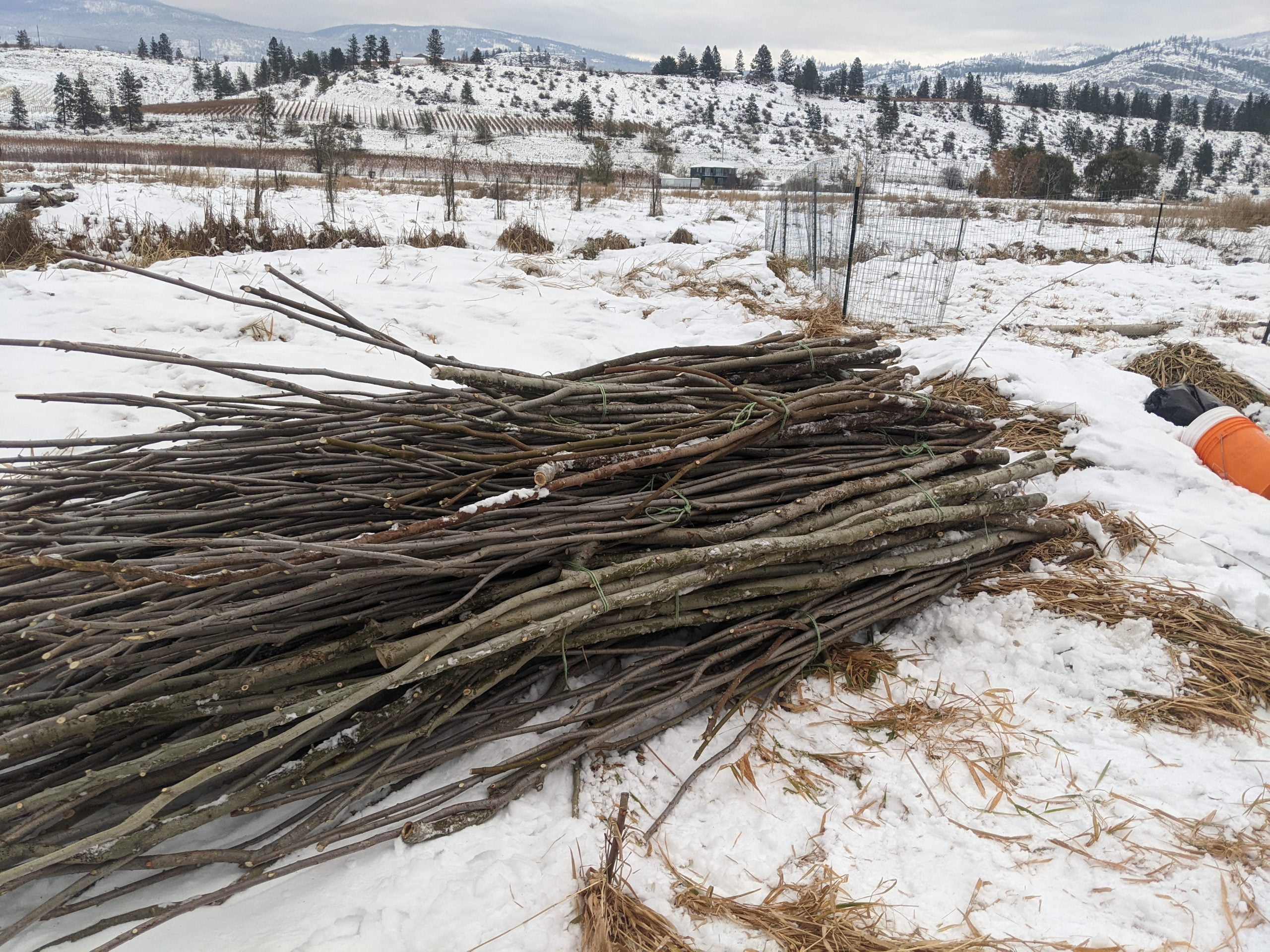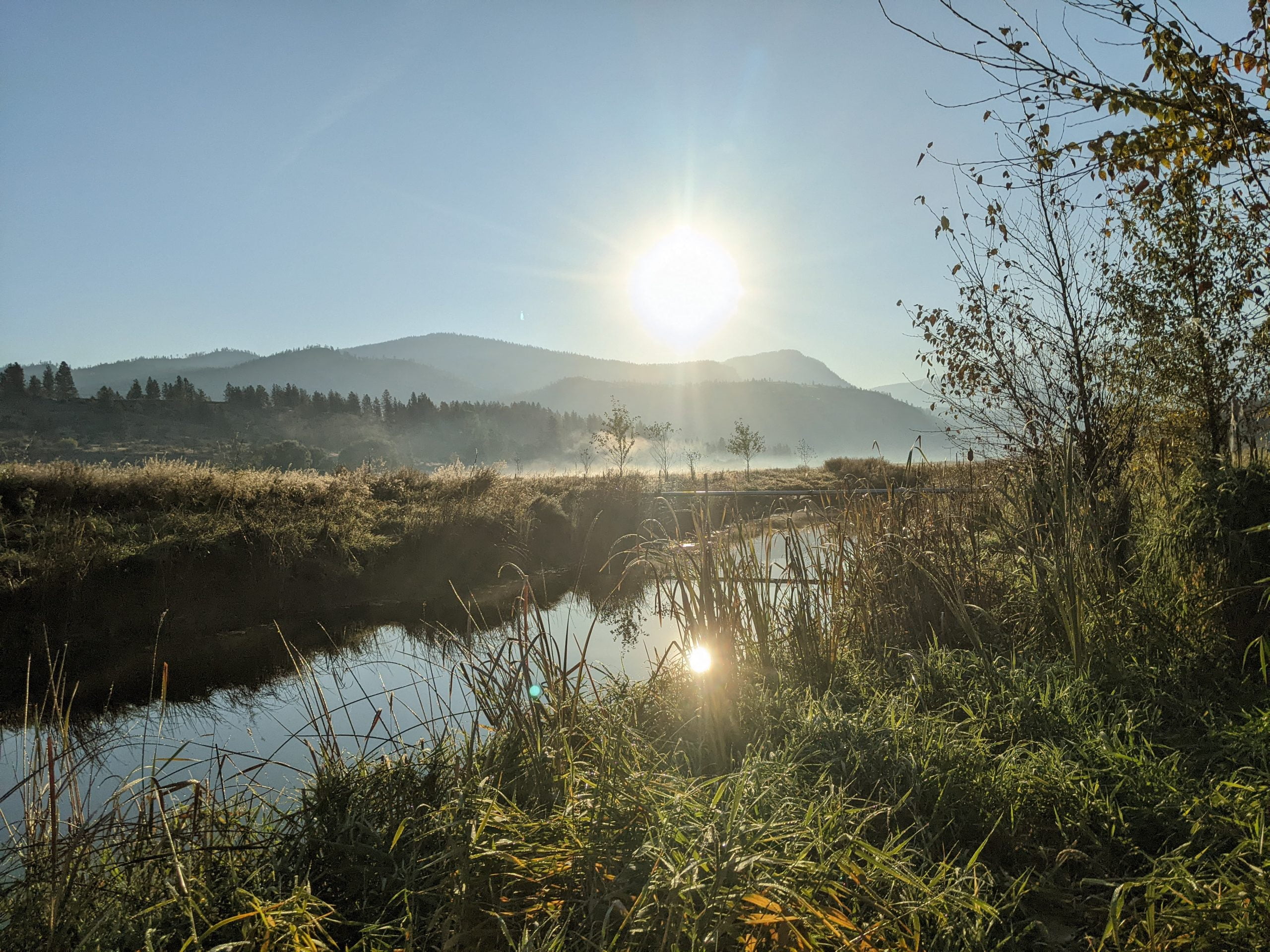Our Methods
At Polster Environmental, we believe in providing innovative and sustainable solutions for every environmental challenge. Utilizing the techniques pioneered by the renowned soil bioengineer, David Polster, we offer a comprehensive and cost-effective solution for a wide range of situations. From erosion control and slope stabilization to river bank and shoreline protection, we have the experience and expertise to address even the most complex challenges.
Nature’s solution for a sustainable future
With our focus on sustainability, we are committed to creating long-lasting solutions that not only protect the environment but also enhance the surrounding landscape. Whether you are a land manager, a developer, or an environmental consultant, we have the tools and techniques to help you achieve your goals. With our expertise and passion for soil bioengineering, we are dedicated to delivering the best possible outcome for your site.
Live Staking
Live Staking offers an Affordable and Versatile Solution for Virtually Every Restoration Scenario. Tried Tested Effective.
Wattle Fencing
Using a willow retaining wall to terrace up a slope. Very effective at restoring steep slopes prone to erosion.
Other Restoration Methods
We have a restoration technique for any situation and often will mix multiple different strategies on one project.
100% Organic
Our techniques involve carefully hand-harvesting these plants during their dormant season while they are not actively growing, and then replanting them in the area that needs restoration. By doing this, we are able to restore a natural pioneering species that helps establish and stabilize the area over time.
Innovative solutions for restoring natural habitats
Soil bioengineering for riparian restoration
A wide variety of soil bioengineering methods have been developed to treat the range of problems that are encountered. This section provides an overview of the soil bioengineering methods that have been developed and used by Polster Environmental Services Ltd. to treat common soil failures. Steep slopes can be treated with methods such as wattle fences, live reinforced earth walls, live smiles, modified brush layers, and brush layers. Sites with excess soil moisture can be treated with live pole drains. Where moving water is causing a problem, live palisades, live silt fences, live bank protection or live gravel bar staking can help. Live staking can be used to re-establish strong root systems on stream banks and slopes. Several soil bioengineering techniques can be used together to solve complex problems. For instance, live pole drains can be used in combination with wattle fences to treat sites where piping failures have caused soil slumps and steep slopes. Soil bioengineering systems are built of living cuttings of pioneering plants so they start the recovery processes of natural successional systems.
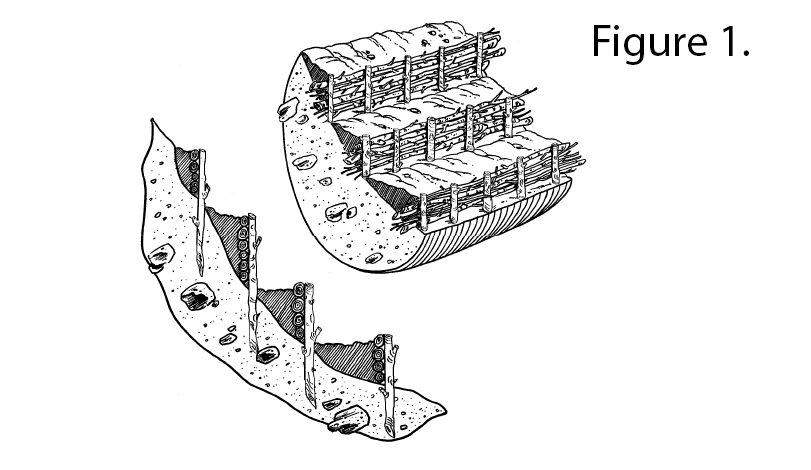
Our techniques involve carefully hand-harvesting these plants during their dormant season while they are not actively growing, and then replanting them in the area that needs restoration. By doing this, we are able to restore a natural pioneering species that helps establish and stabilize the area over time.
Using hand tools, we carefully plant these living wood materials in strategic locations along the slope or in the riparian zone. Our methods are cost-effective, as we do not rely on heavy machinery or complex tools, and they are also long-lasting, as the planted vegetation will continue to grow and thrive over time. The result is a sustainable solution that helps to restore and protect delicate riparian areas, ensuring that they remain healthy and functional for years to come.
At Polster Environmental, we understand the importance of utilizing the right techniques and materials to ensure the success of our restoration projects. Our methods involve the careful selection, harvesting, and replanting of specific plant species known for their ability to stabilize slopes and restore ecosystems.
Species Selection
Choosing the right species is critical to the success of our restoration projects. We focus on native plants that are well-adapted to the local climate and conditions. These species have a natural ability to thrive in their environment and provide the necessary support for a stable and healthy ecosystem.
Harvesting Techniques
We pay close attention to the harvesting process to ensure the health and viability of the cuttings. Our team harvests the plants during their dormant season when they are not actively growing, ensuring minimal stress on the plant material. This allows for a greater chance of successful transplantation and growth in the target restoration area.
Planting Strategies
Using hand tools, we skillfully plant the harvested cuttings in strategic locations along slopes or in riparian zones. By taking into account factors such as slope gradient, soil type, and hydrological conditions, we create a custom planting plan that maximizes the effectiveness of our restoration efforts.
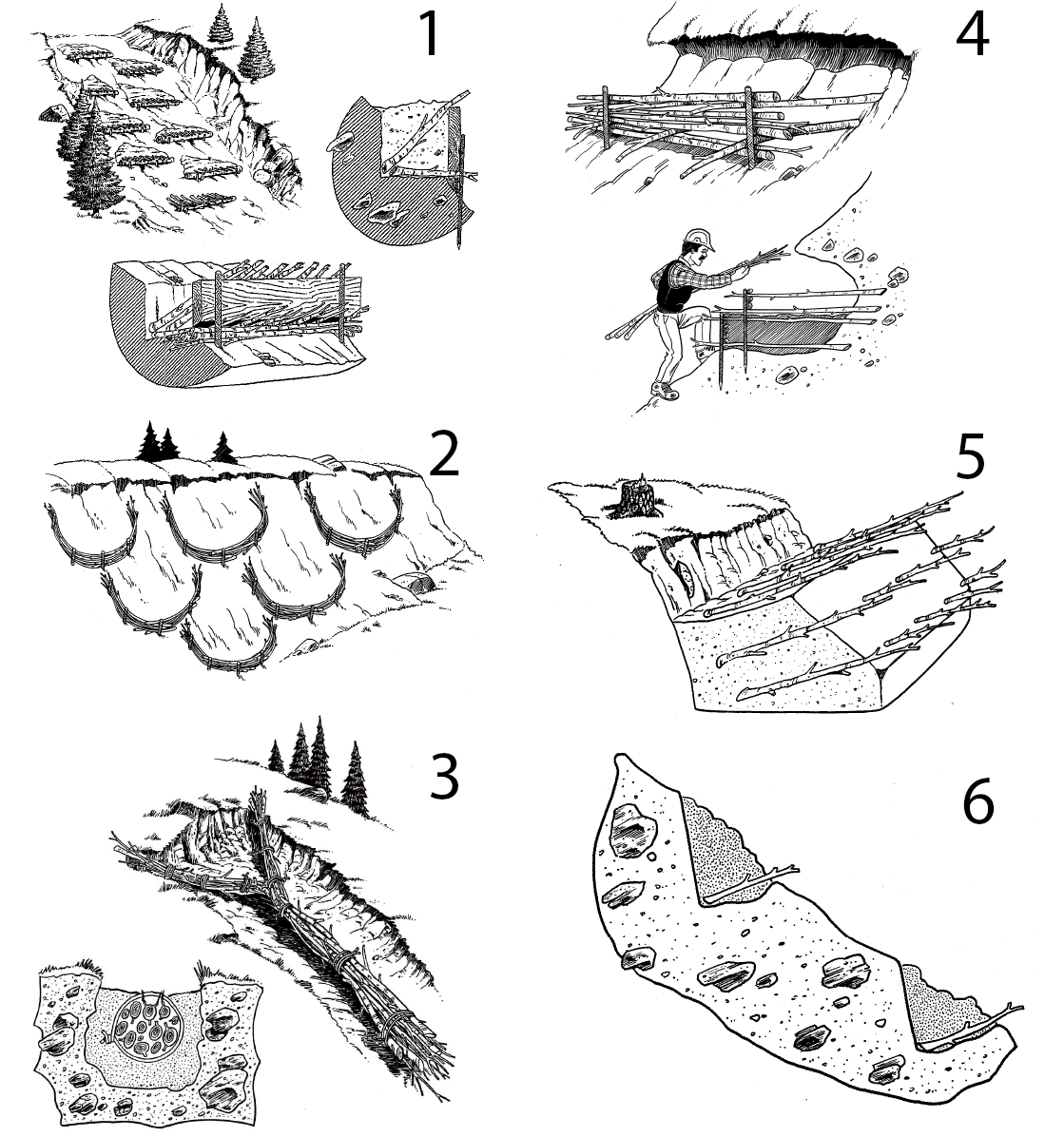
Modified brush layers (1), live smiles (2), live pole drains (3), live reinforced earth walls (4), brush layers in a fill (5) and brush layers in a cut (6) can be used to treat a variety of slope problems.
Long-lasting Results
The living wood materials we use are not only cost-effective, but they also provide long-lasting solutions. As the plants continue to grow and thrive, they establish strong root systems that help stabilize the area and prevent erosion. Over time, these plants contribute to the development of a resilient and self-sustaining ecosystem.
Learn More: Course Manual
To gain a deeper understanding of the specific species and harvesting techniques we use, we invite you to refer to our comprehensive course manual. It contains detailed information on the principles of soil bioengineering, plant species selection, harvesting and planting methodologies, and maintenance practices to ensure long-term success.
At Polster Environmental, we are committed to providing innovative and sustainable solutions for land restoration and slope stabilization. Our methods are grounded in nature’s wisdom, and we take pride in our ability to create lasting, positive change in the environments we serve.
Soil Bioengineering For Riparian Restoration
David F. Polster, M.Sc., R.P. Bio.Paper presented at the Canadian Land Reclamation Association 2006 Conference, Ottawa, Ontario, August 20 – 23, 2006. David F. Polster, M.Sc. R.P.Bio., President, Polster Environmental Services Ltd.
Abstract: Degradation of riparian areas can be traced to a wide variety of causes from urban developments to industrial activities, including mining. Soil bioengineering, where living plant materials are used to perform some engineering function, can be an effective tool in reclaiming damaged riparian areas. Soil bioengineering can be used to treat unstable banks where modified flow regimes or riparian clearing has caused accelerated erosion. Soil bioengineering can be used to treat sites where excessive sediment deposition such as from placer mining has modified flow patterns. Soil bioengineering treatments can be used to trap sediments and to re-establish the functions of riparian vegetation including increasing bank root densities, providing shade, organic matter and insects for aquatic systems. Soil bioengineering treatments are well adapted to implementation by local stewardship groups and can provide an opportunity for low costs riparian restoration. This paper explores the soil bioengineering techniques that can be used to treat degraded riparian areas. A variety of case studies from western Canada are presented.
Key Words: Hardwood cuttings; earth retaining structures; drains; flow modifying systems; sediment control; living plants; riparian vegetation; cost-effective; local labour.
Introduction
Increasing use and/or degradation of riparian areas requires development of effective strategies for restoration. Urban developments, industrial uses, including mining and forestry, as well as agricultural expansion can impact riparian areas, either directly through habitat loss or indirectly by changing hydrologic patterns and increasing peak flows. Urban development can cause significant degradation of riparian areas. Clearing riparian vegetation for houses, roads and infrastructure such as sewer lines, has had and continues to have detrimental impacts on riparian areas. Mining and forestry activities can change flow patterns and even watercourse locations. Agricultural clearing of riparian vegetation or livestock use of riparian areas can result in damaged riparian areas. All of these activities have in common the loss of riparian structure (vegetation, living and dead) and/or riparian function. Soil bioengineering treatments can be used to restore riparian areas and return lost riparian structure and function.
Soil bioengineering is the use of living plant materials to perform some engineering function (Schiechtl 1980). Riparian treatments using soil bioengineering systems can range from simple live staking to complex systems designed to stabilize eroding or slumping banks (Schiechtl and Stern 1997). The plant materials, usually dormant cuttings, used in soil bioengineering systems sprout and take root and form ideal riparian vegetation. The plants used in soil bioengineering are typically pioneering species so the vegetation established with soil bioengineering treatments is early seral and ideal for treatment of damaged or degraded sites (Polster 1989). By using early seral species the restored site is re-aligned with the natural successional trajectory for the area.
Labour for soil bioengineering projects can come from trained crews or from untrained community stewardship groups. Since the techniques are simple and the materials can be collected locally, soil bioengineering treatments are ideally suited to the treatment of small, local problems with local people. However, soil bioengineering can also be used to treat large problems. The basic premise with soil bioengineering treatments is that there is strength in numbers. Where a large eroding slope is causing a problem, rather than building some large structure such as a large retaining wall at the bottom, the soil bioengineering solution would involve a whole series of small retaining walls all the way up the slope (see wattle fences below). Similarly, when erosion problems threaten a streambank rather than building a large rip-rap slope, a soil bioengineering treatment would apply hundreds or even thousands of cuttings (see live gravel bar staking below) that would slow the near surface flood flows and thus prevent the substrate from being eroded and in some cases even allow suspended sediments to be deposited.
This paper explores the use of soil bioengineering systems for treatment of riparian areas that have been damaged, degraded or destroyed by the activities of humans. Natural erosion of river banks or lakeshores is an important process in maintaining gravels for fish spawning and for creating the early seral riparian landscape that is essential to so many biota. Soil bioengineering systems can help to re-establish the natural successional trajectory of riparian ecosystems that have been negatively impacted by humans. As ways in which humans can live lightly on the landscape are sought, soil bioengineering offers treatments that can be applied by local stewardship groups as well as municipal workers. In industrial settings, soil bioengineering offers alternatives to the traditional hard engineering that is applied for slope failures and degraded sites. The soil bioengineering systems discussed in this paper are more fully described in Polster (2005).
Plant Materials
Soil bioengineering methods use living plant materials to build structures to stabilize the problem site. As such, the construction materials must be strong enough to withstand the forces acting on them. In addition, since the intention of building the structures of living materials is that these materials will sprout and grow, the materials must be in a condition that will promote their subsequent growth. The plant materials are typically stem cuttings and must therefore be capable of forming new roots and shoots without special mist tents and bottom heat used in nurseries for plant propagation. Willows (Salix spp.), cottonwood (Populus balsamifera L.) and red-osier dogwood (Cornus stolonifera Michx.) are the only woody native British Columbian species that have been found to reliably root from stem cuttings.
Willows and cottonwood are most commonly used for soil bioengineering projects. These species are used due to their aggressive growth on disturbed sites. The nomenclature of willows is notoriously difficult and the exact identification of the willows used in a soil bioengineering project is not necessary. Typically common willows such as Scouler’s willow (Salix scouleriana Barratt in Hooker), Pacific willow (Salix lucida Muhlenberg), pussy willow (Salix discolor Muhlenberg) and glaucous willow (Salix glauca L.) are used. Although the nomenclature of the
willows that are used is not important, it is essential that species be selected from habitats that approximate those found on the reclamation site. For instance, treatment of a dry raveling slope composed of sandy gravel would not be very effective with willows that were collected from around a marsh. Red-osier dogwood is particularly useful where the treatment site is under the canopy of other vegetation and not in direct sun.
Cuttings used in soil bioengineering projects should follow the “rule of thumb” that is, if it is not as big in diameter as your thumb it is too small. Minimum diameter of the cuttings at the tip end should be at least 2.5 cm, and larger cuttings tend to work better than smaller ones as long as they are not old and decadent. In terms of length, cuttings should be at least 40 cm long and where structures such as wattle fences are being built, the cuttings should be as long as possible. Cuttings that are 6 or 7 m in length can be used to make very strong structures. Trim all of the small branches and twigs from the cutting before using it in a structure. Where live pole drains are being built, trim smaller twigs but pencil sized twigs can be left on the cutting as long as they do not have leaf or twig buds on them.
The cuttings that are collected for soil bioengineering projects need to be handled in such as way that they will retain their viability. Keeping the cuttings cool and moist and avoiding excessive damage to the cambium will help to retain viability. In addition, soaking the cuttings in water for up to 10 days has been found (Becker 2002) to stimulate root development in un-rooted cuttings. Cuttings should be collected during the dormant period for the plant (late fall to early spring) and where timing does not permit immediate use of the cuttings, they can be stored in a cold storage facility (0 to 1 degree C) for several months as long as they are kept moist. Storage of collected cuttings in snow banks has been found to be very effective.
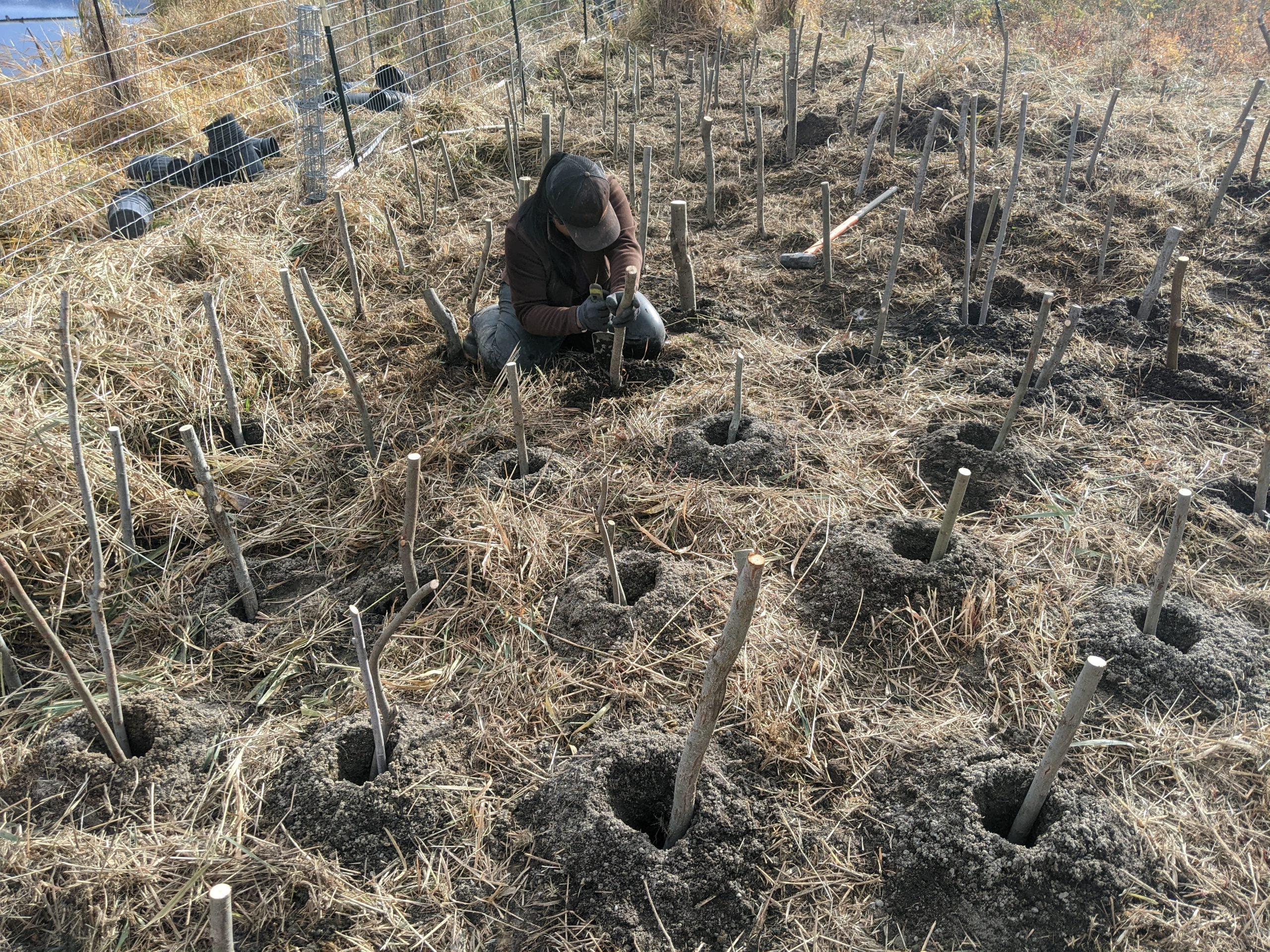
Figure 1. Wattle fences can be used to treat over-steepened slopes. The terracing created by the wattle fences reduces erosion while the growth of the cuttings provides a dense cover of pioneering woody species on the slope.
Live Staking
Live staking is an eco-friendly and cost-effective technique to restore and stabilize and revegetate almost any area. This method involves the use of live stakes, which are stem cuttings taken from trees during their dormant season. These cuttings are then directly inserted into the restoration areas where they will grow into new trees, providing a strong root network to prevent soil erosion and improve the health of the ecosystem.
Live stakes can be sourced from nurseries or harvested from trees on your property, preferably those growing near the restoration areas. Species such as Willow or Red Osier Dogwood and Balsalm Popular are ideal for this purpose. The cuttings should be a minimum of 1 inch in diameter and 1 meter in length, with the bottom cut at an angle to facilitate insertion into the soil.
Planting live stakes is best done during the dormant season before buds break. To plant, create a pilot hole at a 90-degree angle to the soil surface, and insert the pointed end of the stake. Space the stakes 2-3 feet apart in several rows, and ensure they are in contact with the moisture to promote growth.
Initial growth may be slow, as root development is the primary focus in the first year. However, with minimal maintenance, live staking can effectively restore many different ecosystems quickly and efficiently.

Figure 1. Wattle fences can be used to treat over-steepened slopes. The terracing created by the wattle fences reduces erosion while the growth of the cuttings provides a dense cover of pioneering woody species on the slope.
Wattle Fences
Wattle fences are short retaining walls built of living cuttings. Figure 1 shows the typical design for wattle fences. Wattle fences are used on sites where over-steepened slopes are preventing the growth of vegetation. As the cuttings are fairly well exposed, wattle fences work best where there is ample moisture available to sustain the growth of the cuttings. Other techniques such as modified brush layers can be used where sites are drier. Wattle fences can be very effective on streambanks where the moist conditions support the growth of the cuttings and the stepped-back design allows flood flows to pass without damage. In addition, the water flows against the cuttings that provide resistance to erosion, thus protecting the bank from erosion. Wattle fences can be used on very steep slopes as long as the slope itself is globally stable. At the University of British Columbia, wattle fences have been effective at revegetating the sand cliffs with an average slope of the in-situ materials of 70 degrees (see www.serbc.info restoration projects section). Wattle fences can be particularly useful where moisture-sensitive soils are sliding down the slope as they will hold the soil and allow the moisture to drain, improving the stability of the soil.
Live Bank Protection
Live bank protection consist of wattle fences along the bank of the stream to create a woody buffer against further erosion. The construction of the live bank protection must be sufficiently dense so that erosion is avoided. Sometimes twigs and trimmings from the cuttings can be used to fill in gaps between the cuttings and thus avoid erosion. Once the cuttings used in the live bank protection sprout and grow, the resulting vegetation provides good protection against erosion. Live bank protection can be particularly effective along the edges of newly constructed ditches. Brush mats (see Schiechtl and Stern 1997) can be used with live bank protection where erosion is excessive.
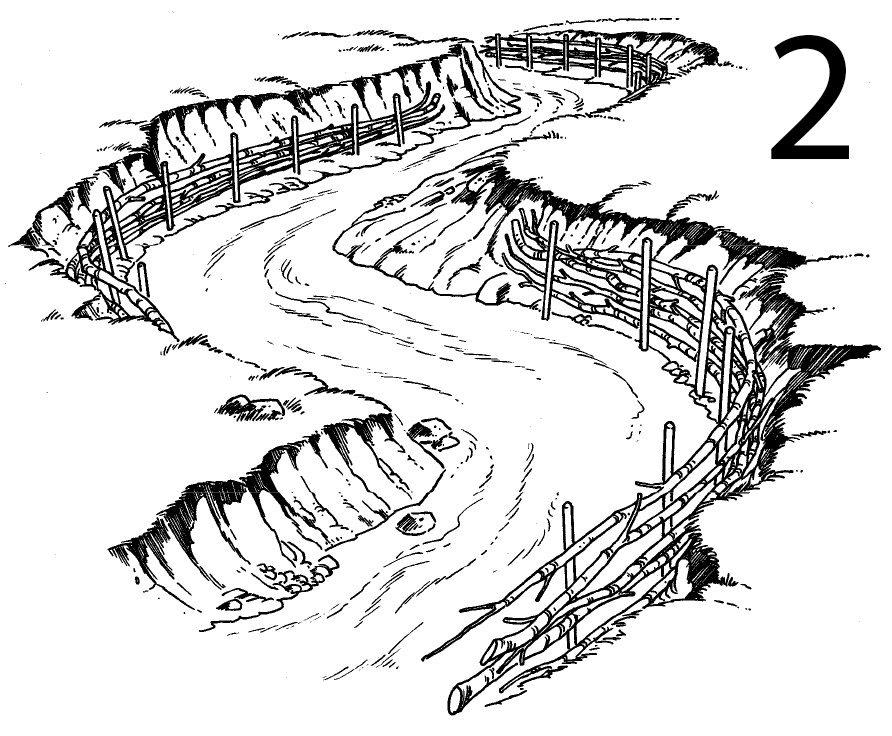
Figure 2. Live bank protection shown here without backfill. Note that the ends of the structures are carefully placed to avoid areas where the current is actively eroding the bank.
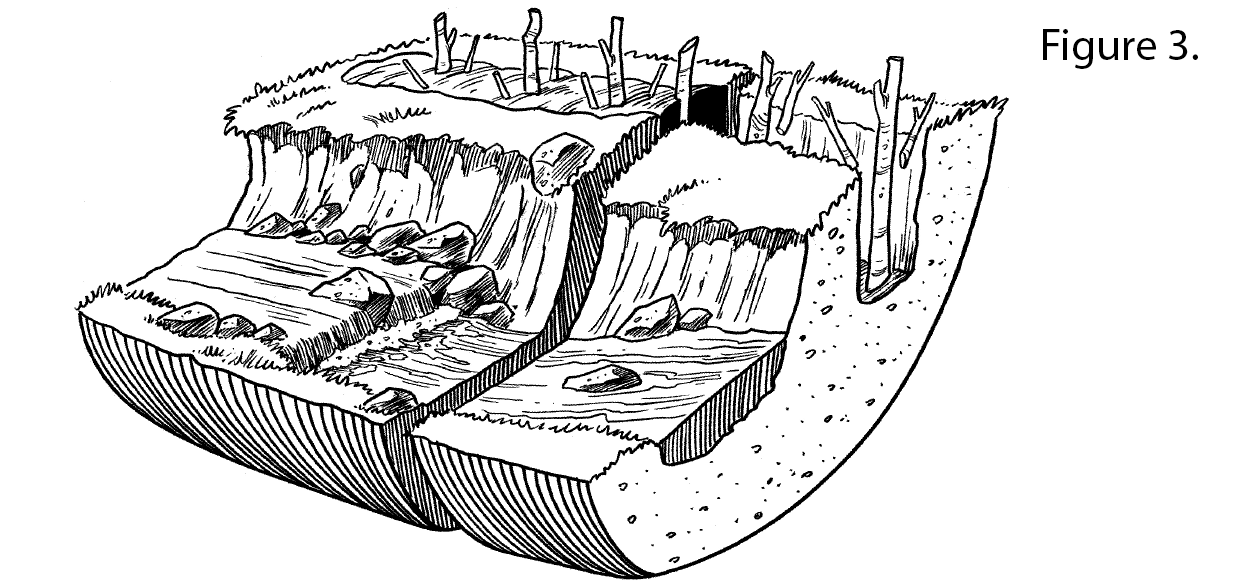
Figure 3. Live palisades consist of a row (or rows) of large cottonwood posts sunk into the water table. Smaller cuttings of willow and red-osier dogwood are inserted in the trench as it is backfilled to provide some diversity to the riparian stand as it develops.
Live Palisades
Live palisades are large cottonwood posts installed in trenches adjacent to the eroding stream or river where the natural riparian vegetation has been lost due to clearing or erosion. Figure 3 shows the typical design for live palisades. The key is to get the cottonwood posts down into the water table so that the trees will grow even during dry weather. Large cottonwood posts (15 to 20 cm diameter by 3 to 4 m long) are inserted into a trench dug by an excavator a few meters away from the actively eroding bank. The cottonwood post is expected to root along its entire below ground length and thus produce a dense cylinder of roots that will protect the bank from erosion as the steam encroaches on the palisade. The large cottonwood posts are placed about 50 cm apart so that the growth of the roots will overlap within one growing season.
Cottonwood roots can grow as much a 1 cm per day during the growing season (Braatne and Rood 1998). Riparian cottonwood trees provide significant riparian benefit when they mature. Care must be taken when establishing live palisades in gravelly alluvial materials that the excavation of the trench for the palisades does not cause an increase in bank instability. Setting the row of palisades well back can help reduce this problem. In some cases, two rows of palisades can be installed in a single trench by simply laying the posts in at an angle. Where fine silty materials are encountered, a tractor mounted post-hole auger with an extension to reach the water table can be an effective tool for inserting the poles. In addition to the cottonwood poles, cuttings of willow and red-osier dogwood can be added to increase the vegetation cover and enhance the diversity.
Live Gravel Bar Staking
Excess gravel deposits in streams and rivers can occur in areas of resource development from erosion of upslope areas. These in turn cause disturbances in the stream flow that result in greater accumulations of sediments downstream. This cycle continues until the stream ends up as a broad expanse of bare gravel with a braided channel and no fish habitat. Live gravel bar staking is designed to establish the natural successional processes that would revegetate the gravel bars and eventually lead to a single channel with well-vegetated banks. The key to live gravel bar staking is to get the cuttings well into the substrate. Use of an excavator is essential (Figure 4). Cuttings should be a minimum of 1 m long and should not protrude from the gravel bar surface more than 20 cm. Large diameter cuttings (4 to 10 cm) appear to work better than smaller stock.
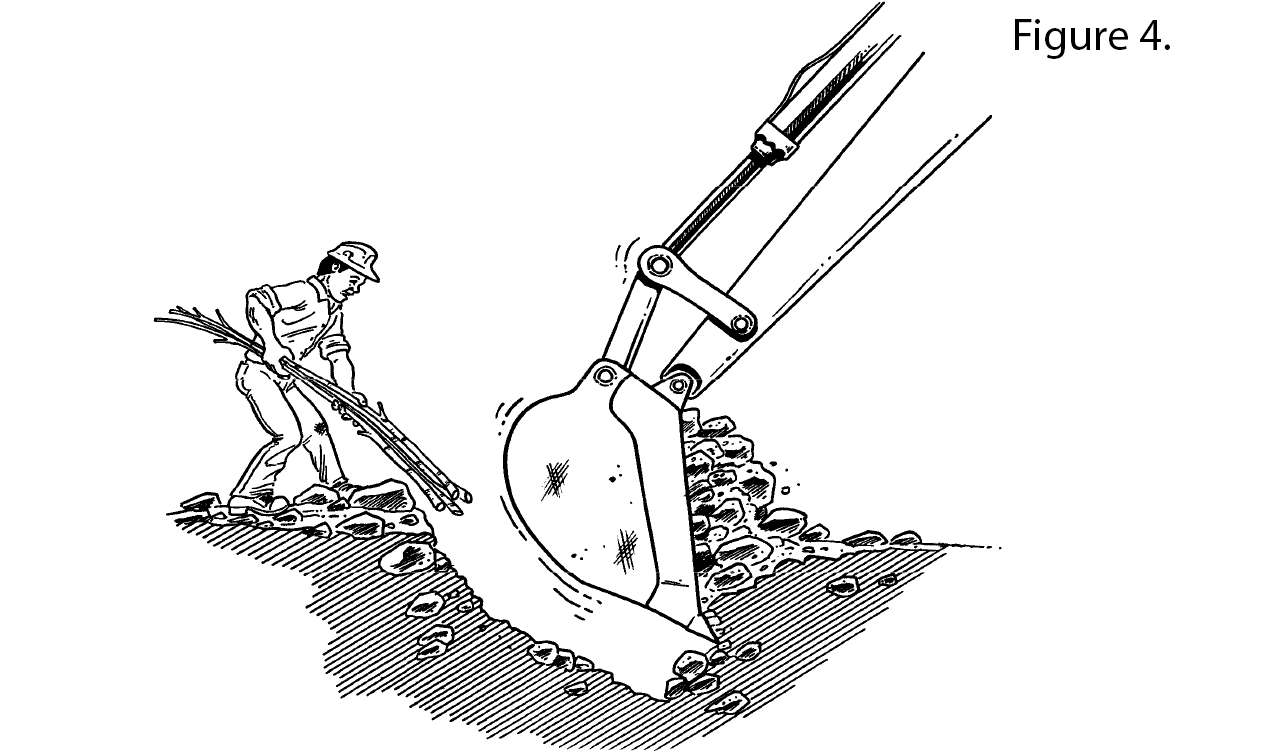
Figure 4. Live gravel bar staking is used to initiate natural succession on bare gravel bars. The sprouted cuttings trap small woody debris that in turn creates a flow disruption that results in deposition of sediment. Once the sediment builds to the point where the sprouts can no longer trap small woody debris there is no more sediment capture until the next year when growth of the sprout again traps woody debris.
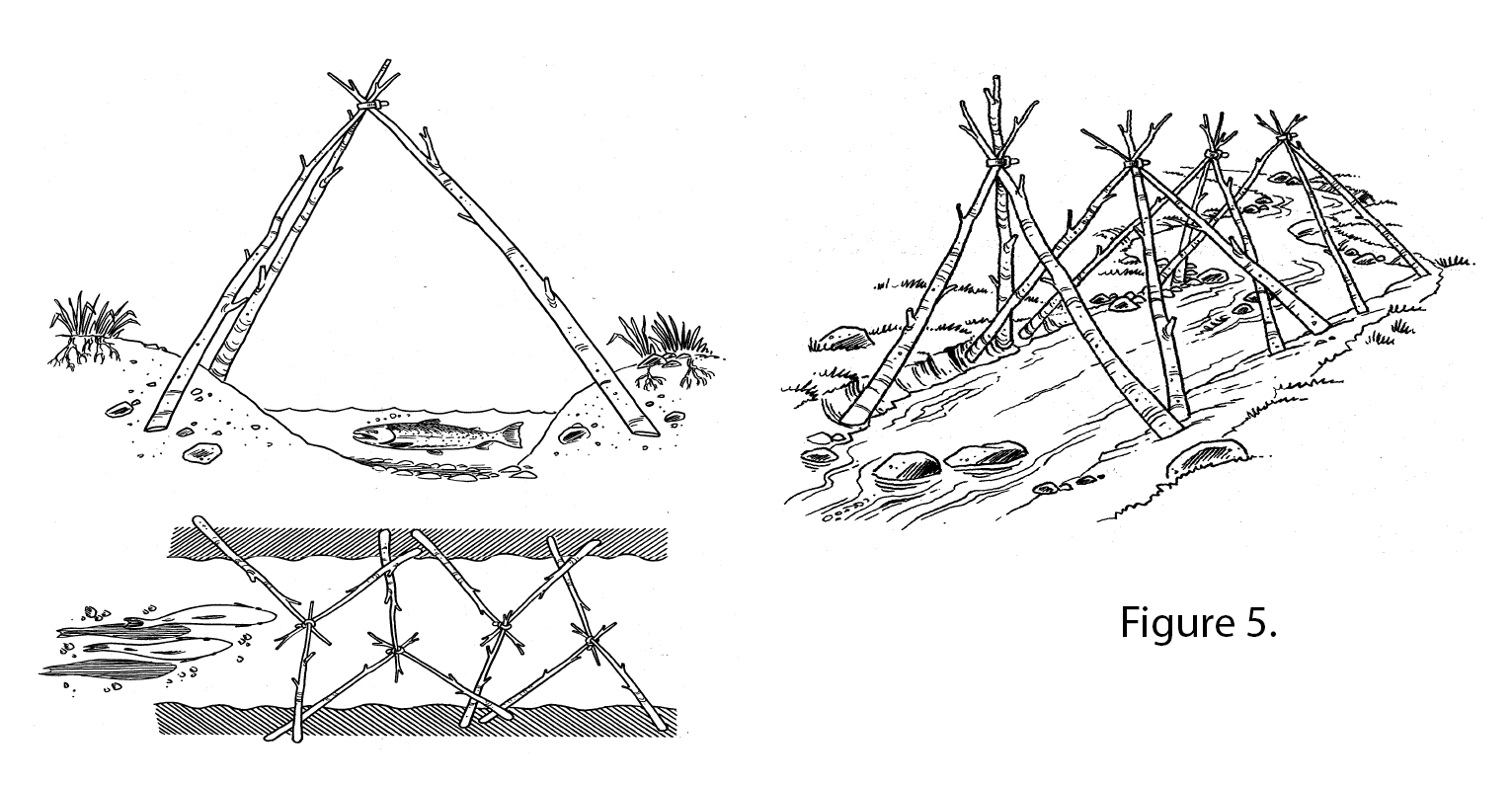
Figure 5. Live shade provides an immediate vegetation cover on newly constructed fish channels and streams where riparian cover has been lost. The spacing of the legs of the tripods can control the density of the shade.
Live Shade
Live shade is designed to provide an immediate vegetation cover over newly constructed offchannel fish habitat and small streams where the riparian cover has been lost. Live shade consists of tripods of living cuttings placed over the stream with the feet sunk into the banks about 50 cm so that ample moisture is assured. The cuttings need to be large enough and strong
enough to easily span the stream and to support the weight of the new growth plus whatever snowfall might be expected in the region where they are applied. Live shade can be used on natural streams and ditches where riparian vegetation has been lost due to clearing. Figure 5 shows the typical design for live shade.
Other Soil Bioengineering Techniques
There are a variety of other soil bioengineering techniques that are typically applied to slopes (Figure 6). Modified brush layers are used to create small terraces on dry raveling slopes where conditions are too dry for wattle fences. Live smiles are used where flowing mud pushes linear structures over. Sites must be relatively moist year-round to sustain live smiles. Live pole drains are used to drain excess moisture from seepage zones causing slope problems. They act like living French drains. Live reinforced earth walls perform like traditional soil reinforced structures except the construction elements sprout and grow. Brush layers in a fill act to prevent circular failures of the fill surface by providing sheer resistance while brush layers in a cut create a wall of vegetation to prevent raveling of the cut slope material.

Figure 6. Modified brush layers (1), live smiles (2), live pole drains (3), live reinforced earth walls (4), brush layers in a fill (5) and brush layers in a cut (6) can be used to treat a variety of slope problems.
CONCLUSIONS
Soil bioengineering techniques can be used to treat a variety of problems that may arise in the restoration of riparian sites. These techniques can protect from erosion and effective riparian vegetation that is congruent with the natural vegetation in the riparian zone. In most cases, these techniques are easy to install and can be constructed by relatively untrained crews or volunteer groups. The diversity of techniques available allows soil bioengineering to address a wide array of problem sites. Soil bioengineering fits nicely between traditional engineering and normal revegetation programs.
REFERENCES CITED
Becker, H. 2002. Soaking willow cuttings helps them protect streambanks. USDA Agricultural Research Service National Sedimentation Laboratory. Oxford, Mississippi (contact person: F. Douglas Shields Jr. ).
Braatne, Jeff H. and Stewart B. Rood. 1998. Strategies for promoting natural recruitment and restoration of riparian cottonwoods and willows. Paper presented at Ecosystem Restoration: Turning the Tide. Society for Ecological Restoration Northwest Chapter Conference and Annual Meeting. Tacoma, Washington.
Clark, J. and J. Hellin. 1996. Bio-engineering for Effective Road Maintenance in the Caribbean. Natural Resources Institute. The University of Greenwich. United Kingdom.
Gray, D.H. and A.T. Leiser. 1982. Biotechnical Slope Protection and Erosion Control. Van Nostrand Reinhold Company Inc. Scarborough, Ontario, 271 pp. (reprinted by Krieger Publishing Co. Malabar, Florida).
Polster, D.F. 1989. Successional reclamation in Western Canada: New light on an old subject. Paper presented at the Canadian Land Reclamation Association and American Society for Surface Mining and Reclamation conference, Calgary, Alberta, August 27-31, 1989.
Polster, D.F. 2005. Soil Bioengineering for Land Restoration and Slope Stabilization. Course materials for training professional and technical staff. Polster Environmental Services Ltd., May 2005.
Schiechtl, H. M. (Trans. N.K. Horstmann, 1980). Bioengineering for Land Reclamation and Conservation. University of Alberta Press. Edmonton. Alberta. 404 pp.
Schiechtl, H.M. and R. Stern. 1996. Ground Bioengineering Techniques for Slope Protection and Erosion Control. Trans. By L. Jaklitsch. Blackwell Scientific. Oxford, U.K. 146 pp.
Schiechtl, H.M. and R. Stern. 1997. Water Bioengineering Techniques for Watercourse, Bank and Shoreline Protection. Trans. By L. Jaklitsch. Blackwell Scientific. Oxford, U.K. 185 pp.

